SNPG927 - Nursing Practice Development Report: Spring 2018 Analysis
VerifiedAdded on 2023/06/03
|12
|3352
|53
Report
AI Summary
This report delves into the development of nursing practice, emphasizing the significance of cultural indicators within healthcare settings. It examines the usefulness of various indicators in assessing and improving patient care, with a particular focus on cultural respect and its impact on quality. The report explores the measurement of these indicators, reviewing literature and models related to clinical supervision and the application of micro-systems to enhance healthcare delivery. It details the PDSA quality care cycle model, principles of risk assessment, and the concept of clinical reasoning, culminating in an evaluation of a quality improvement program and developmental plan. The study underscores the importance of cultural sensitivity and effective workplace culture in achieving optimal patient outcomes. The report highlights the importance of cultural safety, cultural innovation, and cultural respect in healthcare settings. It also emphasizes the role of micro-systems, particularly self-awareness, management of constraints, collaboration, and time management in improving the overall quality of nursing care.
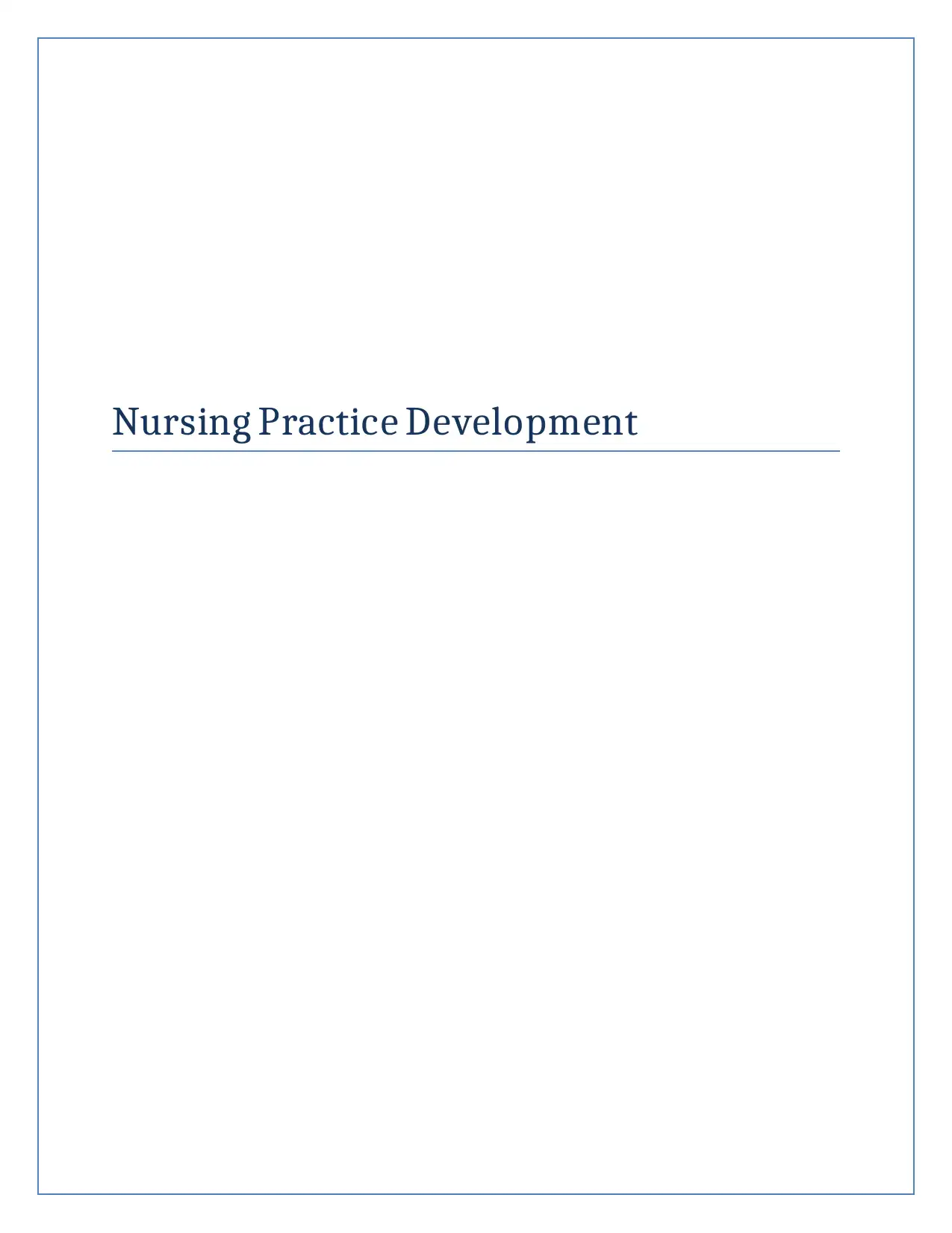
Nursing Practice Development
Paraphrase This Document
Need a fresh take? Get an instant paraphrase of this document with our AI Paraphraser
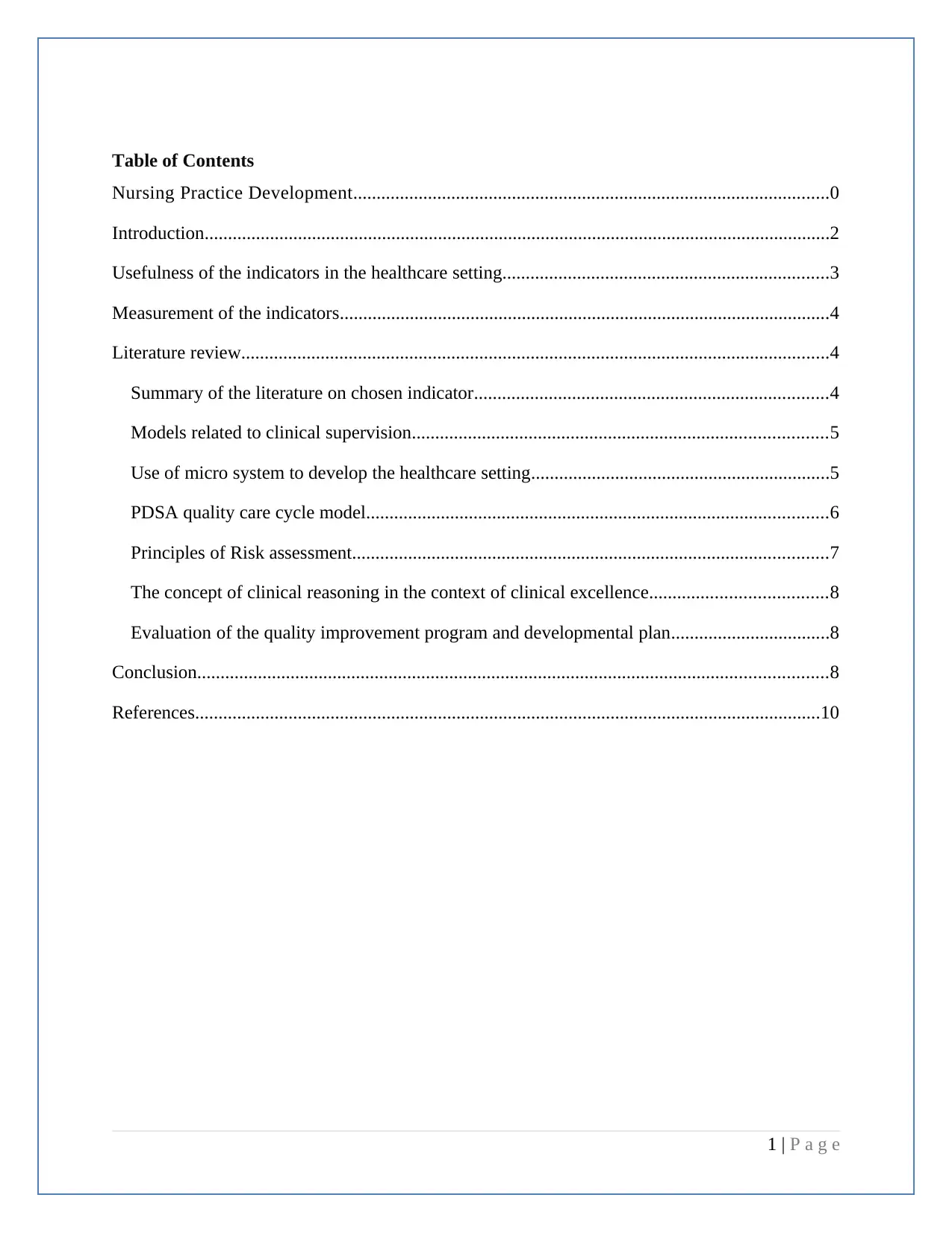
Table of Contents
Nursing Practice Development......................................................................................................0
Introduction......................................................................................................................................2
Usefulness of the indicators in the healthcare setting......................................................................3
Measurement of the indicators.........................................................................................................4
Literature review..............................................................................................................................4
Summary of the literature on chosen indicator............................................................................4
Models related to clinical supervision.........................................................................................5
Use of micro system to develop the healthcare setting................................................................5
PDSA quality care cycle model...................................................................................................6
Principles of Risk assessment......................................................................................................7
The concept of clinical reasoning in the context of clinical excellence......................................8
Evaluation of the quality improvement program and developmental plan..................................8
Conclusion.......................................................................................................................................8
References......................................................................................................................................10
1 | P a g e
Nursing Practice Development......................................................................................................0
Introduction......................................................................................................................................2
Usefulness of the indicators in the healthcare setting......................................................................3
Measurement of the indicators.........................................................................................................4
Literature review..............................................................................................................................4
Summary of the literature on chosen indicator............................................................................4
Models related to clinical supervision.........................................................................................5
Use of micro system to develop the healthcare setting................................................................5
PDSA quality care cycle model...................................................................................................6
Principles of Risk assessment......................................................................................................7
The concept of clinical reasoning in the context of clinical excellence......................................8
Evaluation of the quality improvement program and developmental plan..................................8
Conclusion.......................................................................................................................................8
References......................................................................................................................................10
1 | P a g e
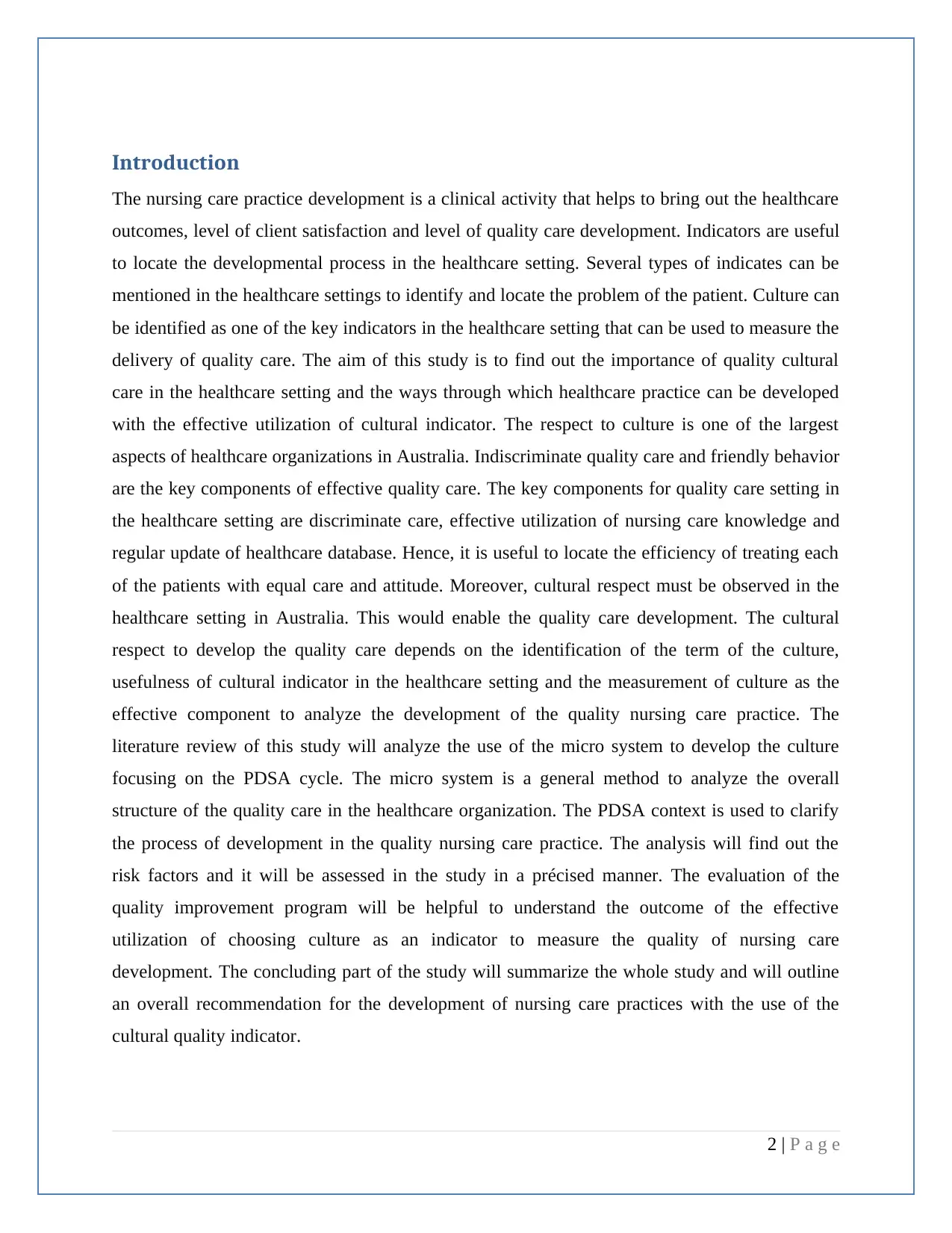
Introduction
The nursing care practice development is a clinical activity that helps to bring out the healthcare
outcomes, level of client satisfaction and level of quality care development. Indicators are useful
to locate the developmental process in the healthcare setting. Several types of indicates can be
mentioned in the healthcare settings to identify and locate the problem of the patient. Culture can
be identified as one of the key indicators in the healthcare setting that can be used to measure the
delivery of quality care. The aim of this study is to find out the importance of quality cultural
care in the healthcare setting and the ways through which healthcare practice can be developed
with the effective utilization of cultural indicator. The respect to culture is one of the largest
aspects of healthcare organizations in Australia. Indiscriminate quality care and friendly behavior
are the key components of effective quality care. The key components for quality care setting in
the healthcare setting are discriminate care, effective utilization of nursing care knowledge and
regular update of healthcare database. Hence, it is useful to locate the efficiency of treating each
of the patients with equal care and attitude. Moreover, cultural respect must be observed in the
healthcare setting in Australia. This would enable the quality care development. The cultural
respect to develop the quality care depends on the identification of the term of the culture,
usefulness of cultural indicator in the healthcare setting and the measurement of culture as the
effective component to analyze the development of the quality nursing care practice. The
literature review of this study will analyze the use of the micro system to develop the culture
focusing on the PDSA cycle. The micro system is a general method to analyze the overall
structure of the quality care in the healthcare organization. The PDSA context is used to clarify
the process of development in the quality nursing care practice. The analysis will find out the
risk factors and it will be assessed in the study in a précised manner. The evaluation of the
quality improvement program will be helpful to understand the outcome of the effective
utilization of choosing culture as an indicator to measure the quality of nursing care
development. The concluding part of the study will summarize the whole study and will outline
an overall recommendation for the development of nursing care practices with the use of the
cultural quality indicator.
2 | P a g e
The nursing care practice development is a clinical activity that helps to bring out the healthcare
outcomes, level of client satisfaction and level of quality care development. Indicators are useful
to locate the developmental process in the healthcare setting. Several types of indicates can be
mentioned in the healthcare settings to identify and locate the problem of the patient. Culture can
be identified as one of the key indicators in the healthcare setting that can be used to measure the
delivery of quality care. The aim of this study is to find out the importance of quality cultural
care in the healthcare setting and the ways through which healthcare practice can be developed
with the effective utilization of cultural indicator. The respect to culture is one of the largest
aspects of healthcare organizations in Australia. Indiscriminate quality care and friendly behavior
are the key components of effective quality care. The key components for quality care setting in
the healthcare setting are discriminate care, effective utilization of nursing care knowledge and
regular update of healthcare database. Hence, it is useful to locate the efficiency of treating each
of the patients with equal care and attitude. Moreover, cultural respect must be observed in the
healthcare setting in Australia. This would enable the quality care development. The cultural
respect to develop the quality care depends on the identification of the term of the culture,
usefulness of cultural indicator in the healthcare setting and the measurement of culture as the
effective component to analyze the development of the quality nursing care practice. The
literature review of this study will analyze the use of the micro system to develop the culture
focusing on the PDSA cycle. The micro system is a general method to analyze the overall
structure of the quality care in the healthcare organization. The PDSA context is used to clarify
the process of development in the quality nursing care practice. The analysis will find out the
risk factors and it will be assessed in the study in a précised manner. The evaluation of the
quality improvement program will be helpful to understand the outcome of the effective
utilization of choosing culture as an indicator to measure the quality of nursing care
development. The concluding part of the study will summarize the whole study and will outline
an overall recommendation for the development of nursing care practices with the use of the
cultural quality indicator.
2 | P a g e
⊘ This is a preview!⊘
Do you want full access?
Subscribe today to unlock all pages.

Trusted by 1+ million students worldwide
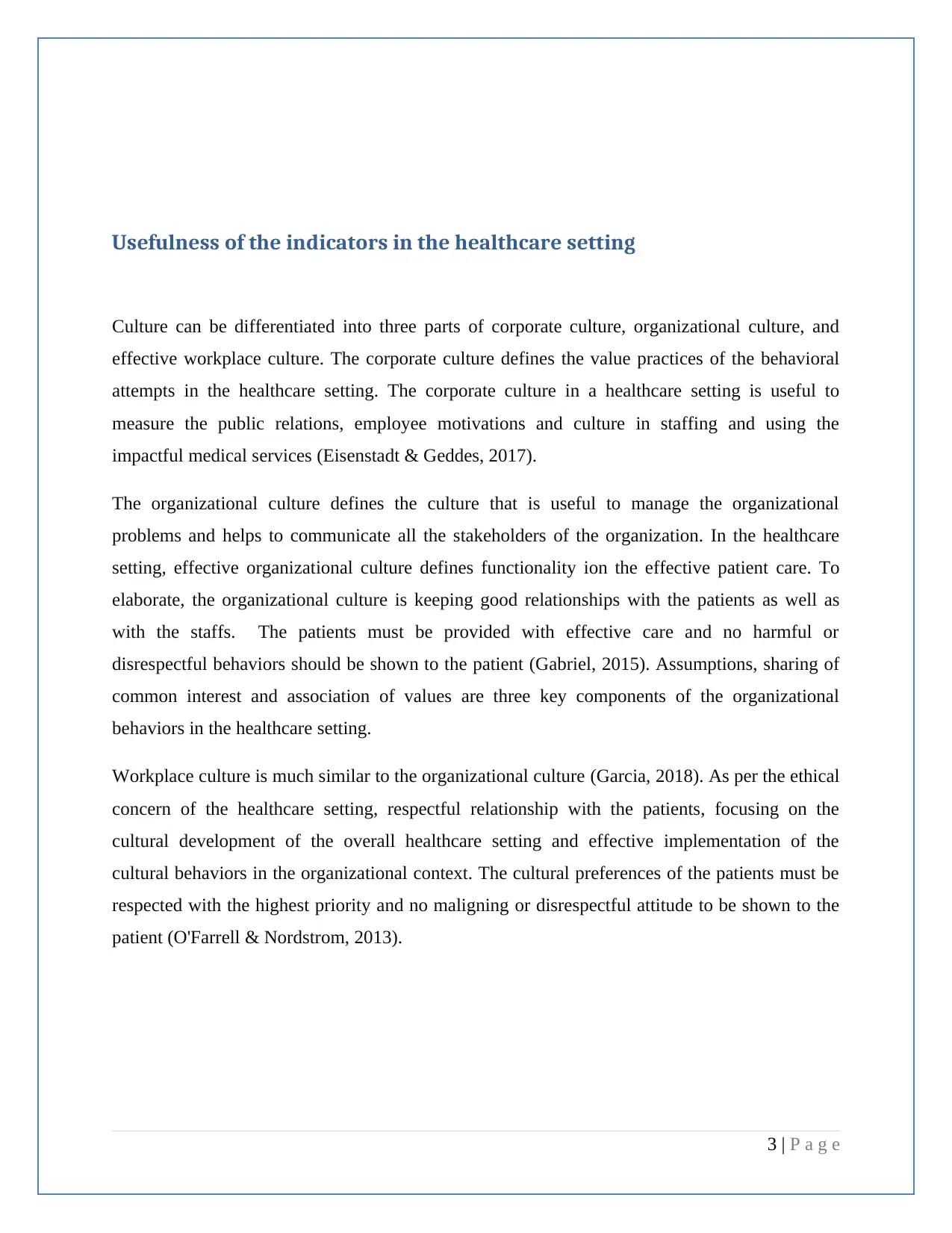
Usefulness of the indicators in the healthcare setting
Culture can be differentiated into three parts of corporate culture, organizational culture, and
effective workplace culture. The corporate culture defines the value practices of the behavioral
attempts in the healthcare setting. The corporate culture in a healthcare setting is useful to
measure the public relations, employee motivations and culture in staffing and using the
impactful medical services (Eisenstadt & Geddes, 2017).
The organizational culture defines the culture that is useful to manage the organizational
problems and helps to communicate all the stakeholders of the organization. In the healthcare
setting, effective organizational culture defines functionality ion the effective patient care. To
elaborate, the organizational culture is keeping good relationships with the patients as well as
with the staffs. The patients must be provided with effective care and no harmful or
disrespectful behaviors should be shown to the patient (Gabriel, 2015). Assumptions, sharing of
common interest and association of values are three key components of the organizational
behaviors in the healthcare setting.
Workplace culture is much similar to the organizational culture (Garcia, 2018). As per the ethical
concern of the healthcare setting, respectful relationship with the patients, focusing on the
cultural development of the overall healthcare setting and effective implementation of the
cultural behaviors in the organizational context. The cultural preferences of the patients must be
respected with the highest priority and no maligning or disrespectful attitude to be shown to the
patient (O'Farrell & Nordstrom, 2013).
3 | P a g e
Culture can be differentiated into three parts of corporate culture, organizational culture, and
effective workplace culture. The corporate culture defines the value practices of the behavioral
attempts in the healthcare setting. The corporate culture in a healthcare setting is useful to
measure the public relations, employee motivations and culture in staffing and using the
impactful medical services (Eisenstadt & Geddes, 2017).
The organizational culture defines the culture that is useful to manage the organizational
problems and helps to communicate all the stakeholders of the organization. In the healthcare
setting, effective organizational culture defines functionality ion the effective patient care. To
elaborate, the organizational culture is keeping good relationships with the patients as well as
with the staffs. The patients must be provided with effective care and no harmful or
disrespectful behaviors should be shown to the patient (Gabriel, 2015). Assumptions, sharing of
common interest and association of values are three key components of the organizational
behaviors in the healthcare setting.
Workplace culture is much similar to the organizational culture (Garcia, 2018). As per the ethical
concern of the healthcare setting, respectful relationship with the patients, focusing on the
cultural development of the overall healthcare setting and effective implementation of the
cultural behaviors in the organizational context. The cultural preferences of the patients must be
respected with the highest priority and no maligning or disrespectful attitude to be shown to the
patient (O'Farrell & Nordstrom, 2013).
3 | P a g e
Paraphrase This Document
Need a fresh take? Get an instant paraphrase of this document with our AI Paraphraser
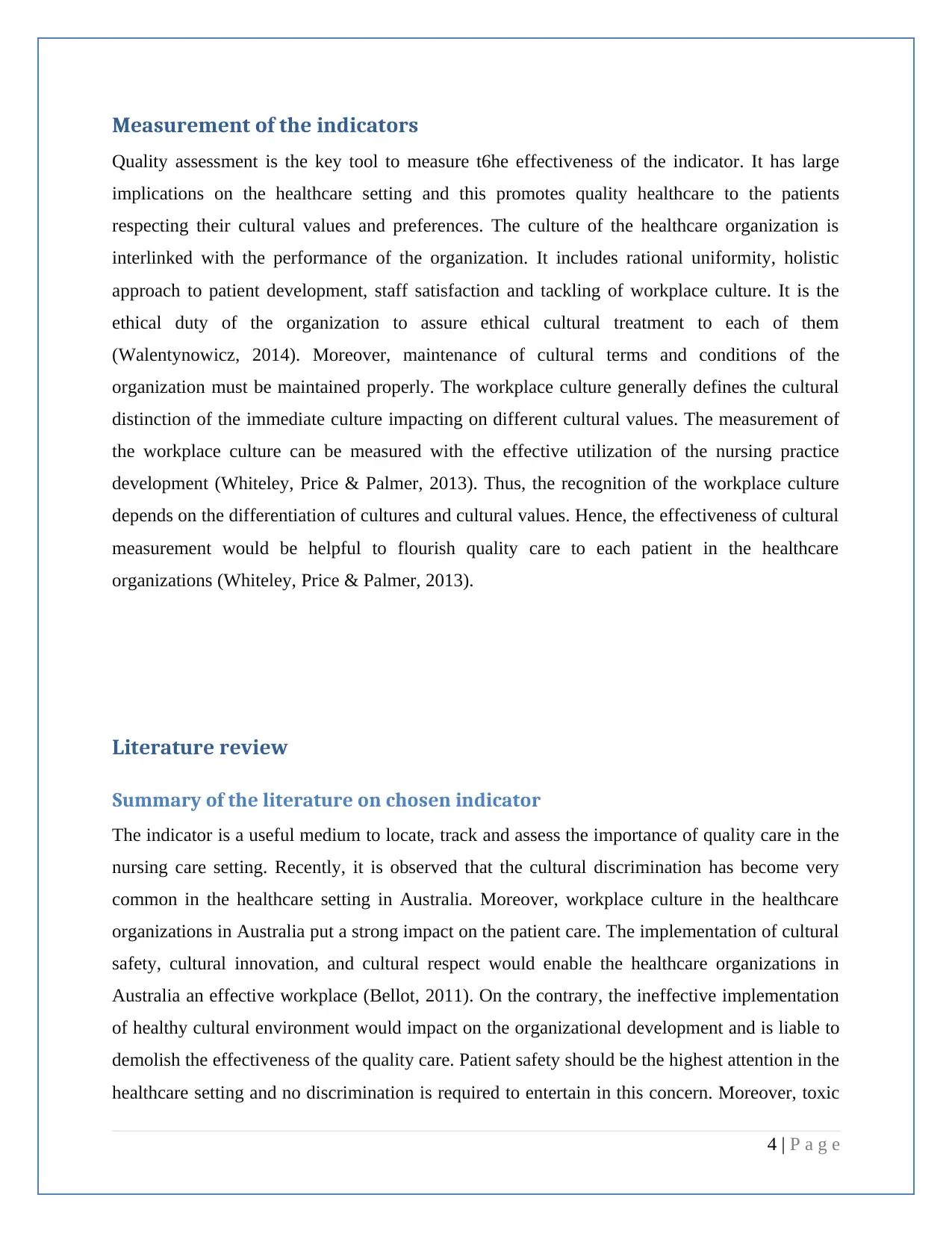
Measurement of the indicators
Quality assessment is the key tool to measure t6he effectiveness of the indicator. It has large
implications on the healthcare setting and this promotes quality healthcare to the patients
respecting their cultural values and preferences. The culture of the healthcare organization is
interlinked with the performance of the organization. It includes rational uniformity, holistic
approach to patient development, staff satisfaction and tackling of workplace culture. It is the
ethical duty of the organization to assure ethical cultural treatment to each of them
(Walentynowicz, 2014). Moreover, maintenance of cultural terms and conditions of the
organization must be maintained properly. The workplace culture generally defines the cultural
distinction of the immediate culture impacting on different cultural values. The measurement of
the workplace culture can be measured with the effective utilization of the nursing practice
development (Whiteley, Price & Palmer, 2013). Thus, the recognition of the workplace culture
depends on the differentiation of cultures and cultural values. Hence, the effectiveness of cultural
measurement would be helpful to flourish quality care to each patient in the healthcare
organizations (Whiteley, Price & Palmer, 2013).
Literature review
Summary of the literature on chosen indicator
The indicator is a useful medium to locate, track and assess the importance of quality care in the
nursing care setting. Recently, it is observed that the cultural discrimination has become very
common in the healthcare setting in Australia. Moreover, workplace culture in the healthcare
organizations in Australia put a strong impact on the patient care. The implementation of cultural
safety, cultural innovation, and cultural respect would enable the healthcare organizations in
Australia an effective workplace (Bellot, 2011). On the contrary, the ineffective implementation
of healthy cultural environment would impact on the organizational development and is liable to
demolish the effectiveness of the quality care. Patient safety should be the highest attention in the
healthcare setting and no discrimination is required to entertain in this concern. Moreover, toxic
4 | P a g e
Quality assessment is the key tool to measure t6he effectiveness of the indicator. It has large
implications on the healthcare setting and this promotes quality healthcare to the patients
respecting their cultural values and preferences. The culture of the healthcare organization is
interlinked with the performance of the organization. It includes rational uniformity, holistic
approach to patient development, staff satisfaction and tackling of workplace culture. It is the
ethical duty of the organization to assure ethical cultural treatment to each of them
(Walentynowicz, 2014). Moreover, maintenance of cultural terms and conditions of the
organization must be maintained properly. The workplace culture generally defines the cultural
distinction of the immediate culture impacting on different cultural values. The measurement of
the workplace culture can be measured with the effective utilization of the nursing practice
development (Whiteley, Price & Palmer, 2013). Thus, the recognition of the workplace culture
depends on the differentiation of cultures and cultural values. Hence, the effectiveness of cultural
measurement would be helpful to flourish quality care to each patient in the healthcare
organizations (Whiteley, Price & Palmer, 2013).
Literature review
Summary of the literature on chosen indicator
The indicator is a useful medium to locate, track and assess the importance of quality care in the
nursing care setting. Recently, it is observed that the cultural discrimination has become very
common in the healthcare setting in Australia. Moreover, workplace culture in the healthcare
organizations in Australia put a strong impact on the patient care. The implementation of cultural
safety, cultural innovation, and cultural respect would enable the healthcare organizations in
Australia an effective workplace (Bellot, 2011). On the contrary, the ineffective implementation
of healthy cultural environment would impact on the organizational development and is liable to
demolish the effectiveness of the quality care. Patient safety should be the highest attention in the
healthcare setting and no discrimination is required to entertain in this concern. Moreover, toxic
4 | P a g e
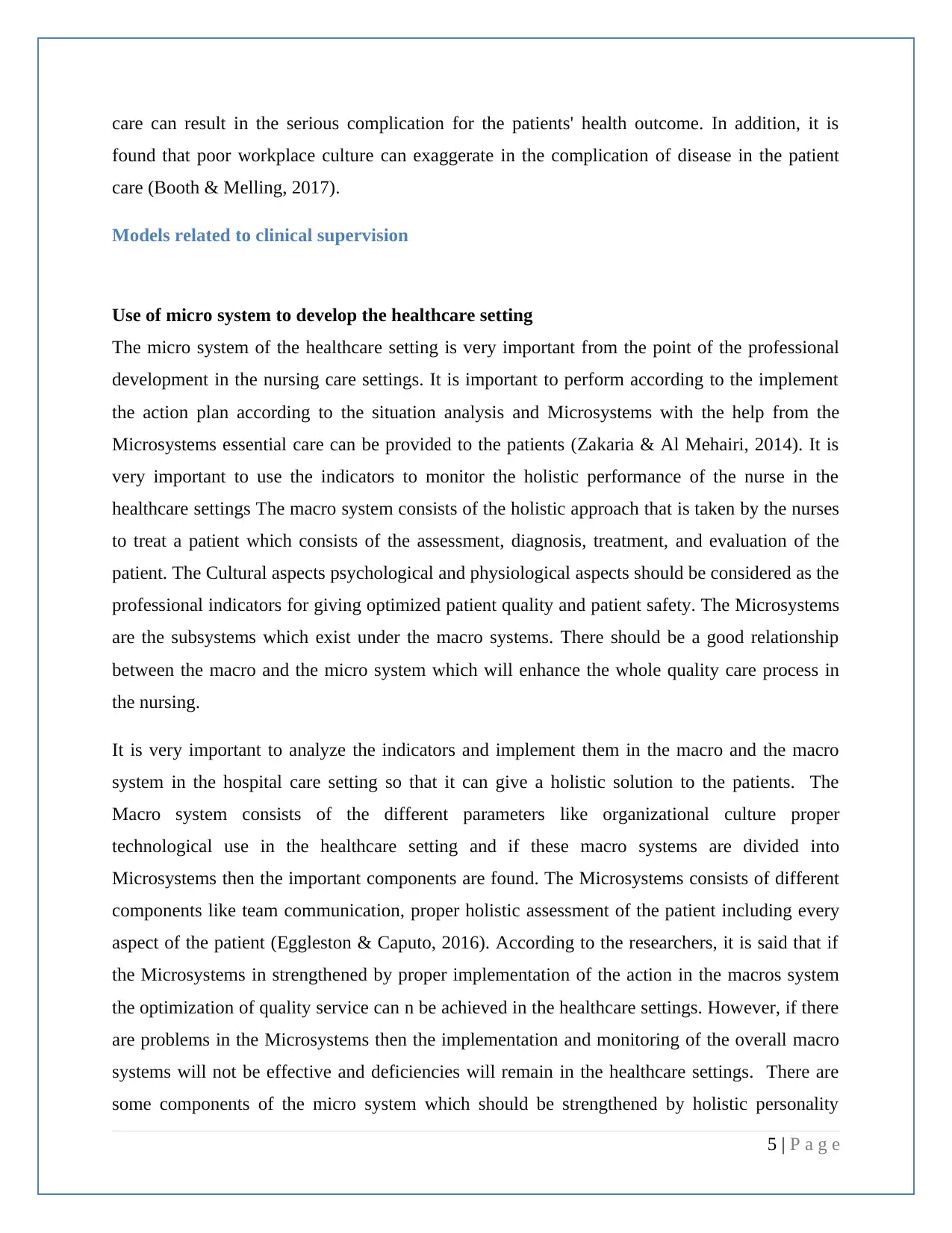
care can result in the serious complication for the patients' health outcome. In addition, it is
found that poor workplace culture can exaggerate in the complication of disease in the patient
care (Booth & Melling, 2017).
Models related to clinical supervision
Use of micro system to develop the healthcare setting
The micro system of the healthcare setting is very important from the point of the professional
development in the nursing care settings. It is important to perform according to the implement
the action plan according to the situation analysis and Microsystems with the help from the
Microsystems essential care can be provided to the patients (Zakaria & Al Mehairi, 2014). It is
very important to use the indicators to monitor the holistic performance of the nurse in the
healthcare settings The macro system consists of the holistic approach that is taken by the nurses
to treat a patient which consists of the assessment, diagnosis, treatment, and evaluation of the
patient. The Cultural aspects psychological and physiological aspects should be considered as the
professional indicators for giving optimized patient quality and patient safety. The Microsystems
are the subsystems which exist under the macro systems. There should be a good relationship
between the macro and the micro system which will enhance the whole quality care process in
the nursing.
It is very important to analyze the indicators and implement them in the macro and the macro
system in the hospital care setting so that it can give a holistic solution to the patients. The
Macro system consists of the different parameters like organizational culture proper
technological use in the healthcare setting and if these macro systems are divided into
Microsystems then the important components are found. The Microsystems consists of different
components like team communication, proper holistic assessment of the patient including every
aspect of the patient (Eggleston & Caputo, 2016). According to the researchers, it is said that if
the Microsystems in strengthened by proper implementation of the action in the macros system
the optimization of quality service can n be achieved in the healthcare settings. However, if there
are problems in the Microsystems then the implementation and monitoring of the overall macro
systems will not be effective and deficiencies will remain in the healthcare settings. There are
some components of the micro system which should be strengthened by holistic personality
5 | P a g e
found that poor workplace culture can exaggerate in the complication of disease in the patient
care (Booth & Melling, 2017).
Models related to clinical supervision
Use of micro system to develop the healthcare setting
The micro system of the healthcare setting is very important from the point of the professional
development in the nursing care settings. It is important to perform according to the implement
the action plan according to the situation analysis and Microsystems with the help from the
Microsystems essential care can be provided to the patients (Zakaria & Al Mehairi, 2014). It is
very important to use the indicators to monitor the holistic performance of the nurse in the
healthcare settings The macro system consists of the holistic approach that is taken by the nurses
to treat a patient which consists of the assessment, diagnosis, treatment, and evaluation of the
patient. The Cultural aspects psychological and physiological aspects should be considered as the
professional indicators for giving optimized patient quality and patient safety. The Microsystems
are the subsystems which exist under the macro systems. There should be a good relationship
between the macro and the micro system which will enhance the whole quality care process in
the nursing.
It is very important to analyze the indicators and implement them in the macro and the macro
system in the hospital care setting so that it can give a holistic solution to the patients. The
Macro system consists of the different parameters like organizational culture proper
technological use in the healthcare setting and if these macro systems are divided into
Microsystems then the important components are found. The Microsystems consists of different
components like team communication, proper holistic assessment of the patient including every
aspect of the patient (Eggleston & Caputo, 2016). According to the researchers, it is said that if
the Microsystems in strengthened by proper implementation of the action in the macros system
the optimization of quality service can n be achieved in the healthcare settings. However, if there
are problems in the Microsystems then the implementation and monitoring of the overall macro
systems will not be effective and deficiencies will remain in the healthcare settings. There are
some components of the micro system which should be strengthened by holistic personality
5 | P a g e
⊘ This is a preview!⊘
Do you want full access?
Subscribe today to unlock all pages.

Trusted by 1+ million students worldwide
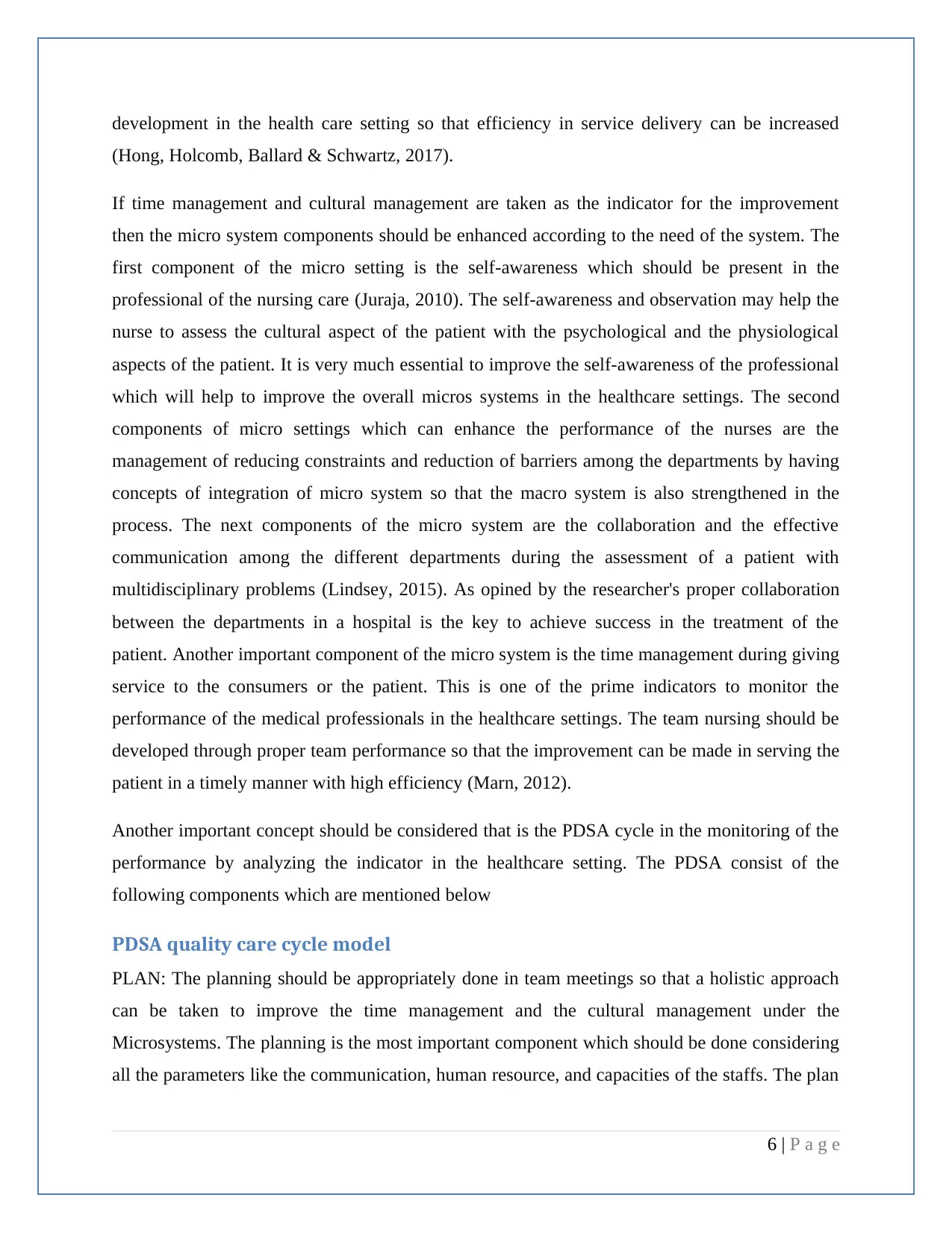
development in the health care setting so that efficiency in service delivery can be increased
(Hong, Holcomb, Ballard & Schwartz, 2017).
If time management and cultural management are taken as the indicator for the improvement
then the micro system components should be enhanced according to the need of the system. The
first component of the micro setting is the self-awareness which should be present in the
professional of the nursing care (Juraja, 2010). The self-awareness and observation may help the
nurse to assess the cultural aspect of the patient with the psychological and the physiological
aspects of the patient. It is very much essential to improve the self-awareness of the professional
which will help to improve the overall micros systems in the healthcare settings. The second
components of micro settings which can enhance the performance of the nurses are the
management of reducing constraints and reduction of barriers among the departments by having
concepts of integration of micro system so that the macro system is also strengthened in the
process. The next components of the micro system are the collaboration and the effective
communication among the different departments during the assessment of a patient with
multidisciplinary problems (Lindsey, 2015). As opined by the researcher's proper collaboration
between the departments in a hospital is the key to achieve success in the treatment of the
patient. Another important component of the micro system is the time management during giving
service to the consumers or the patient. This is one of the prime indicators to monitor the
performance of the medical professionals in the healthcare settings. The team nursing should be
developed through proper team performance so that the improvement can be made in serving the
patient in a timely manner with high efficiency (Marn, 2012).
Another important concept should be considered that is the PDSA cycle in the monitoring of the
performance by analyzing the indicator in the healthcare setting. The PDSA consist of the
following components which are mentioned below
PDSA quality care cycle model
PLAN: The planning should be appropriately done in team meetings so that a holistic approach
can be taken to improve the time management and the cultural management under the
Microsystems. The planning is the most important component which should be done considering
all the parameters like the communication, human resource, and capacities of the staffs. The plan
6 | P a g e
(Hong, Holcomb, Ballard & Schwartz, 2017).
If time management and cultural management are taken as the indicator for the improvement
then the micro system components should be enhanced according to the need of the system. The
first component of the micro setting is the self-awareness which should be present in the
professional of the nursing care (Juraja, 2010). The self-awareness and observation may help the
nurse to assess the cultural aspect of the patient with the psychological and the physiological
aspects of the patient. It is very much essential to improve the self-awareness of the professional
which will help to improve the overall micros systems in the healthcare settings. The second
components of micro settings which can enhance the performance of the nurses are the
management of reducing constraints and reduction of barriers among the departments by having
concepts of integration of micro system so that the macro system is also strengthened in the
process. The next components of the micro system are the collaboration and the effective
communication among the different departments during the assessment of a patient with
multidisciplinary problems (Lindsey, 2015). As opined by the researcher's proper collaboration
between the departments in a hospital is the key to achieve success in the treatment of the
patient. Another important component of the micro system is the time management during giving
service to the consumers or the patient. This is one of the prime indicators to monitor the
performance of the medical professionals in the healthcare settings. The team nursing should be
developed through proper team performance so that the improvement can be made in serving the
patient in a timely manner with high efficiency (Marn, 2012).
Another important concept should be considered that is the PDSA cycle in the monitoring of the
performance by analyzing the indicator in the healthcare setting. The PDSA consist of the
following components which are mentioned below
PDSA quality care cycle model
PLAN: The planning should be appropriately done in team meetings so that a holistic approach
can be taken to improve the time management and the cultural management under the
Microsystems. The planning is the most important component which should be done considering
all the parameters like the communication, human resource, and capacities of the staffs. The plan
6 | P a g e
Paraphrase This Document
Need a fresh take? Get an instant paraphrase of this document with our AI Paraphraser
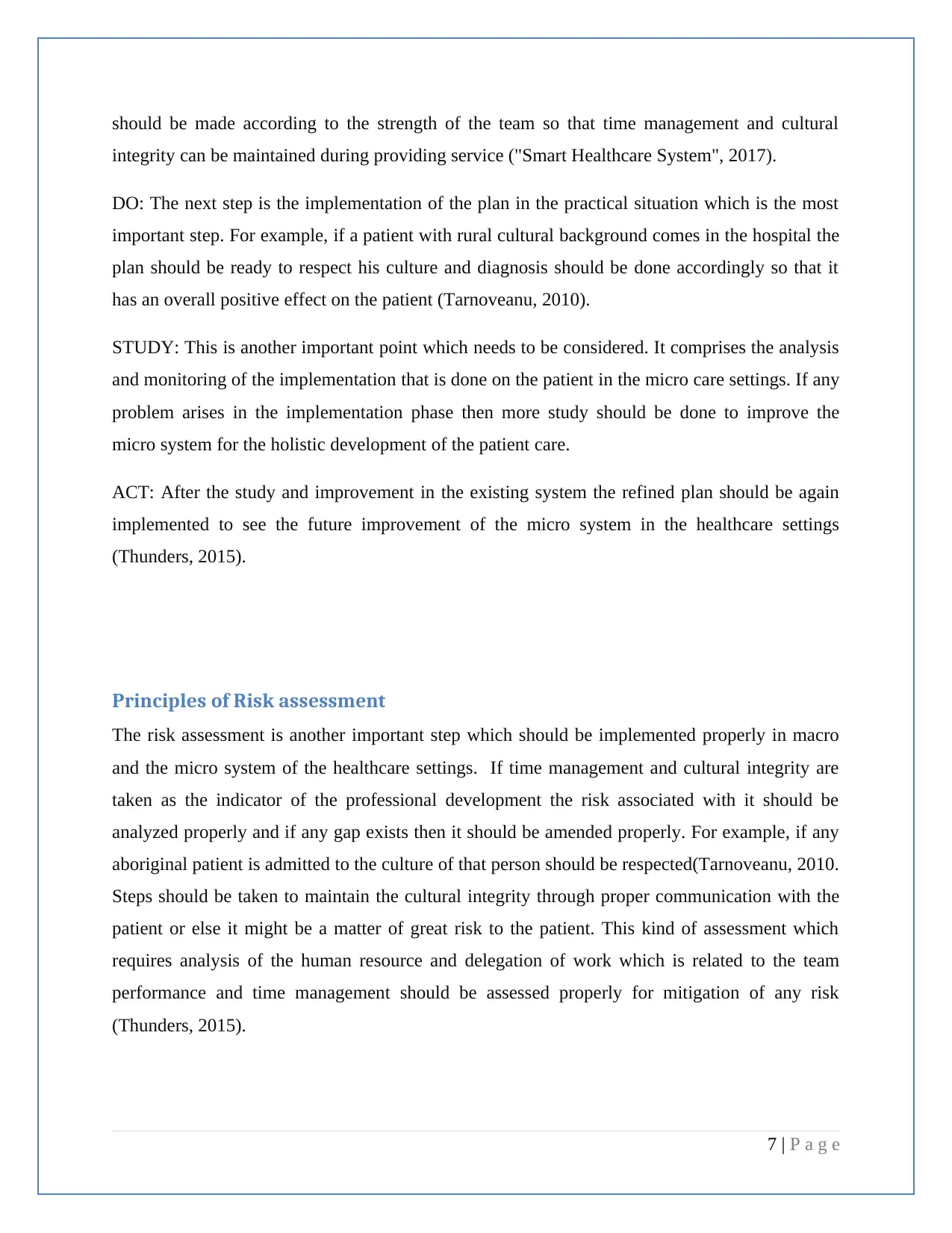
should be made according to the strength of the team so that time management and cultural
integrity can be maintained during providing service ("Smart Healthcare System", 2017).
DO: The next step is the implementation of the plan in the practical situation which is the most
important step. For example, if a patient with rural cultural background comes in the hospital the
plan should be ready to respect his culture and diagnosis should be done accordingly so that it
has an overall positive effect on the patient (Tarnoveanu, 2010).
STUDY: This is another important point which needs to be considered. It comprises the analysis
and monitoring of the implementation that is done on the patient in the micro care settings. If any
problem arises in the implementation phase then more study should be done to improve the
micro system for the holistic development of the patient care.
ACT: After the study and improvement in the existing system the refined plan should be again
implemented to see the future improvement of the micro system in the healthcare settings
(Thunders, 2015).
Principles of Risk assessment
The risk assessment is another important step which should be implemented properly in macro
and the micro system of the healthcare settings. If time management and cultural integrity are
taken as the indicator of the professional development the risk associated with it should be
analyzed properly and if any gap exists then it should be amended properly. For example, if any
aboriginal patient is admitted to the culture of that person should be respected(Tarnoveanu, 2010.
Steps should be taken to maintain the cultural integrity through proper communication with the
patient or else it might be a matter of great risk to the patient. This kind of assessment which
requires analysis of the human resource and delegation of work which is related to the team
performance and time management should be assessed properly for mitigation of any risk
(Thunders, 2015).
7 | P a g e
integrity can be maintained during providing service ("Smart Healthcare System", 2017).
DO: The next step is the implementation of the plan in the practical situation which is the most
important step. For example, if a patient with rural cultural background comes in the hospital the
plan should be ready to respect his culture and diagnosis should be done accordingly so that it
has an overall positive effect on the patient (Tarnoveanu, 2010).
STUDY: This is another important point which needs to be considered. It comprises the analysis
and monitoring of the implementation that is done on the patient in the micro care settings. If any
problem arises in the implementation phase then more study should be done to improve the
micro system for the holistic development of the patient care.
ACT: After the study and improvement in the existing system the refined plan should be again
implemented to see the future improvement of the micro system in the healthcare settings
(Thunders, 2015).
Principles of Risk assessment
The risk assessment is another important step which should be implemented properly in macro
and the micro system of the healthcare settings. If time management and cultural integrity are
taken as the indicator of the professional development the risk associated with it should be
analyzed properly and if any gap exists then it should be amended properly. For example, if any
aboriginal patient is admitted to the culture of that person should be respected(Tarnoveanu, 2010.
Steps should be taken to maintain the cultural integrity through proper communication with the
patient or else it might be a matter of great risk to the patient. This kind of assessment which
requires analysis of the human resource and delegation of work which is related to the team
performance and time management should be assessed properly for mitigation of any risk
(Thunders, 2015).
7 | P a g e
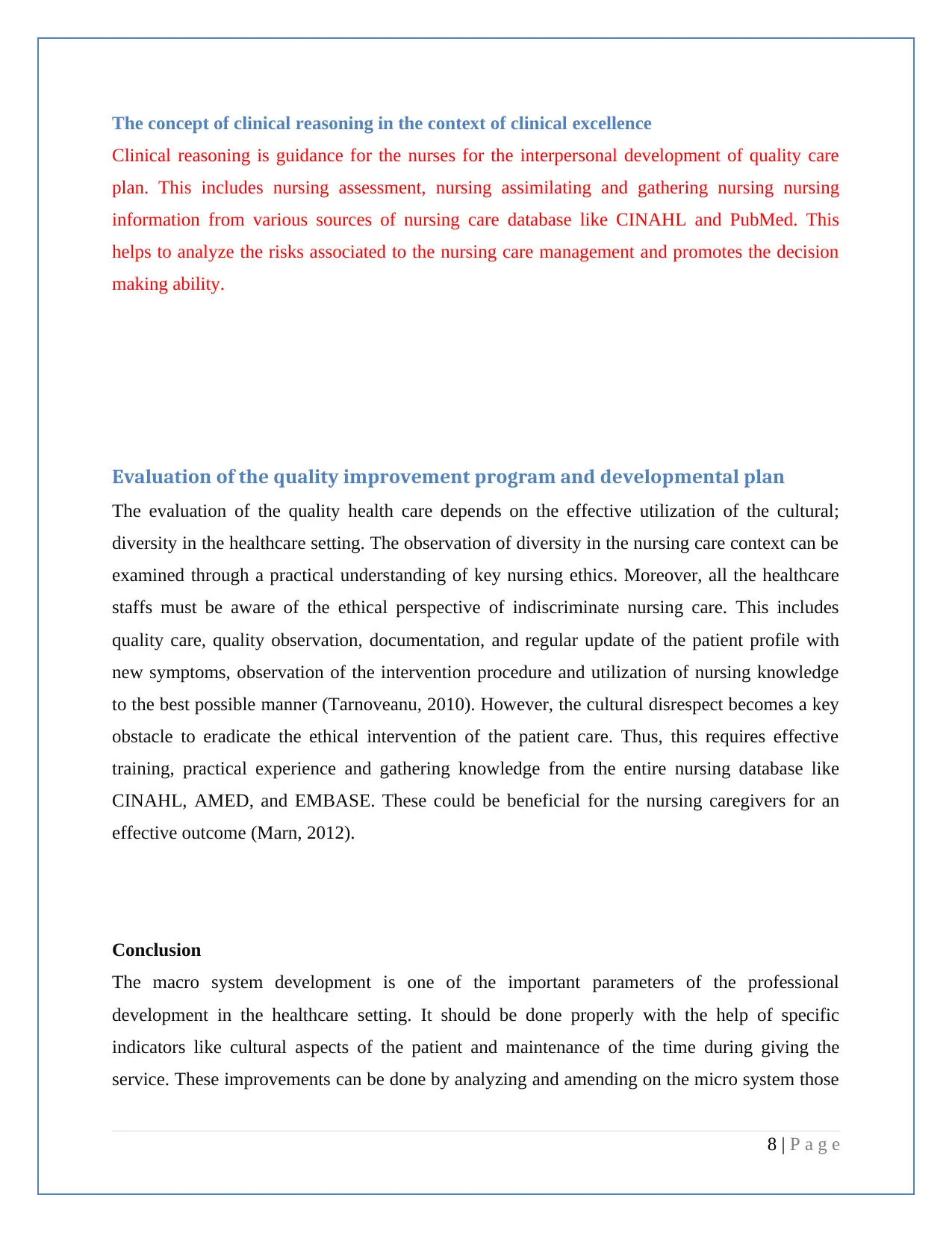
The concept of clinical reasoning in the context of clinical excellence
Clinical reasoning is guidance for the nurses for the interpersonal development of quality care
plan. This includes nursing assessment, nursing assimilating and gathering nursing nursing
information from various sources of nursing care database like CINAHL and PubMed. This
helps to analyze the risks associated to the nursing care management and promotes the decision
making ability.
Evaluation of the quality improvement program and developmental plan
The evaluation of the quality health care depends on the effective utilization of the cultural;
diversity in the healthcare setting. The observation of diversity in the nursing care context can be
examined through a practical understanding of key nursing ethics. Moreover, all the healthcare
staffs must be aware of the ethical perspective of indiscriminate nursing care. This includes
quality care, quality observation, documentation, and regular update of the patient profile with
new symptoms, observation of the intervention procedure and utilization of nursing knowledge
to the best possible manner (Tarnoveanu, 2010). However, the cultural disrespect becomes a key
obstacle to eradicate the ethical intervention of the patient care. Thus, this requires effective
training, practical experience and gathering knowledge from the entire nursing database like
CINAHL, AMED, and EMBASE. These could be beneficial for the nursing caregivers for an
effective outcome (Marn, 2012).
Conclusion
The macro system development is one of the important parameters of the professional
development in the healthcare setting. It should be done properly with the help of specific
indicators like cultural aspects of the patient and maintenance of the time during giving the
service. These improvements can be done by analyzing and amending on the micro system those
8 | P a g e
Clinical reasoning is guidance for the nurses for the interpersonal development of quality care
plan. This includes nursing assessment, nursing assimilating and gathering nursing nursing
information from various sources of nursing care database like CINAHL and PubMed. This
helps to analyze the risks associated to the nursing care management and promotes the decision
making ability.
Evaluation of the quality improvement program and developmental plan
The evaluation of the quality health care depends on the effective utilization of the cultural;
diversity in the healthcare setting. The observation of diversity in the nursing care context can be
examined through a practical understanding of key nursing ethics. Moreover, all the healthcare
staffs must be aware of the ethical perspective of indiscriminate nursing care. This includes
quality care, quality observation, documentation, and regular update of the patient profile with
new symptoms, observation of the intervention procedure and utilization of nursing knowledge
to the best possible manner (Tarnoveanu, 2010). However, the cultural disrespect becomes a key
obstacle to eradicate the ethical intervention of the patient care. Thus, this requires effective
training, practical experience and gathering knowledge from the entire nursing database like
CINAHL, AMED, and EMBASE. These could be beneficial for the nursing caregivers for an
effective outcome (Marn, 2012).
Conclusion
The macro system development is one of the important parameters of the professional
development in the healthcare setting. It should be done properly with the help of specific
indicators like cultural aspects of the patient and maintenance of the time during giving the
service. These improvements can be done by analyzing and amending on the micro system those
8 | P a g e
⊘ This is a preview!⊘
Do you want full access?
Subscribe today to unlock all pages.

Trusted by 1+ million students worldwide
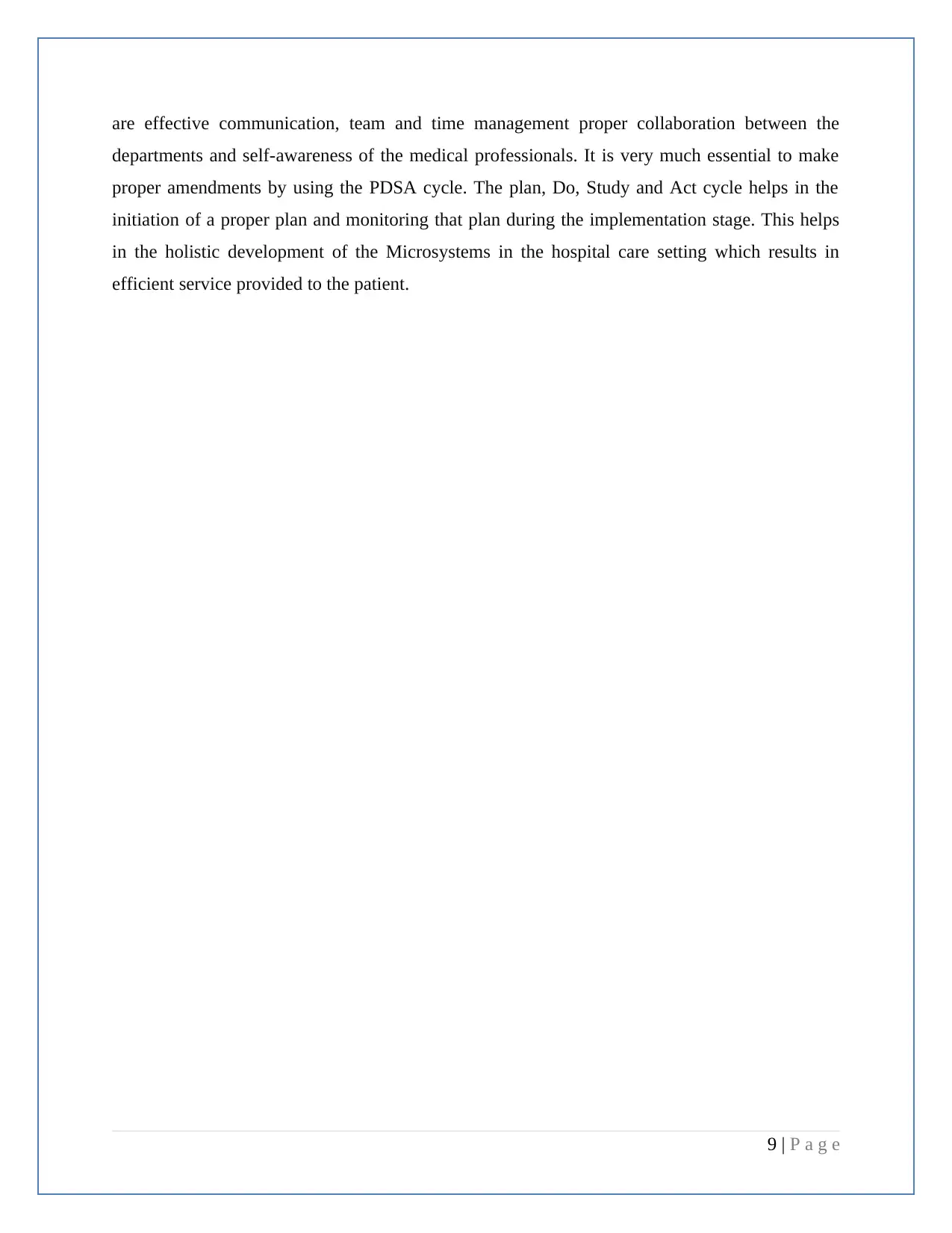
are effective communication, team and time management proper collaboration between the
departments and self-awareness of the medical professionals. It is very much essential to make
proper amendments by using the PDSA cycle. The plan, Do, Study and Act cycle helps in the
initiation of a proper plan and monitoring that plan during the implementation stage. This helps
in the holistic development of the Microsystems in the hospital care setting which results in
efficient service provided to the patient.
9 | P a g e
departments and self-awareness of the medical professionals. It is very much essential to make
proper amendments by using the PDSA cycle. The plan, Do, Study and Act cycle helps in the
initiation of a proper plan and monitoring that plan during the implementation stage. This helps
in the holistic development of the Microsystems in the hospital care setting which results in
efficient service provided to the patient.
9 | P a g e
Paraphrase This Document
Need a fresh take? Get an instant paraphrase of this document with our AI Paraphraser
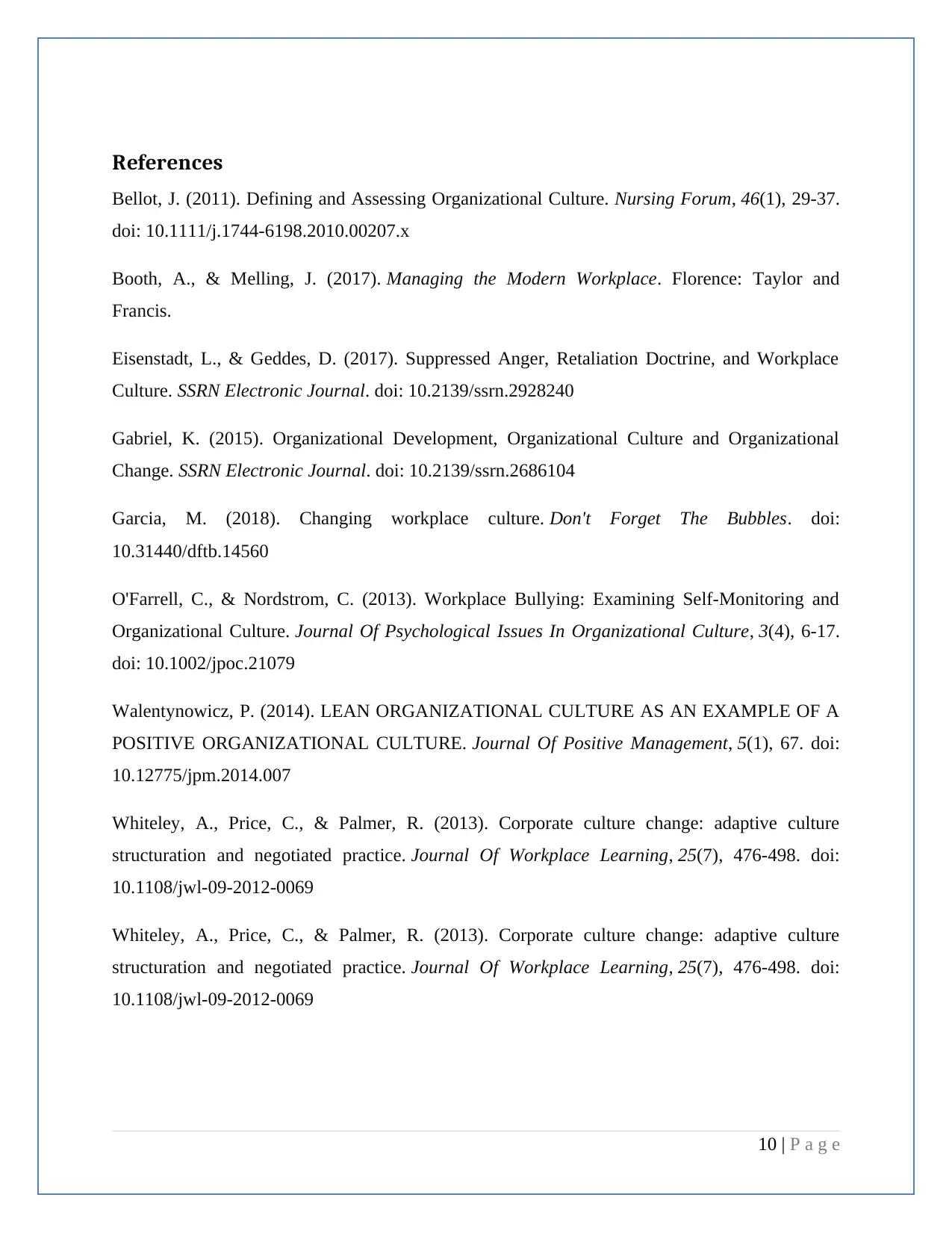
References
Bellot, J. (2011). Defining and Assessing Organizational Culture. Nursing Forum, 46(1), 29-37.
doi: 10.1111/j.1744-6198.2010.00207.x
Booth, A., & Melling, J. (2017). Managing the Modern Workplace. Florence: Taylor and
Francis.
Eisenstadt, L., & Geddes, D. (2017). Suppressed Anger, Retaliation Doctrine, and Workplace
Culture. SSRN Electronic Journal. doi: 10.2139/ssrn.2928240
Gabriel, K. (2015). Organizational Development, Organizational Culture and Organizational
Change. SSRN Electronic Journal. doi: 10.2139/ssrn.2686104
Garcia, M. (2018). Changing workplace culture. Don't Forget The Bubbles. doi:
10.31440/dftb.14560
O'Farrell, C., & Nordstrom, C. (2013). Workplace Bullying: Examining Self-Monitoring and
Organizational Culture. Journal Of Psychological Issues In Organizational Culture, 3(4), 6-17.
doi: 10.1002/jpoc.21079
Walentynowicz, P. (2014). LEAN ORGANIZATIONAL CULTURE AS AN EXAMPLE OF A
POSITIVE ORGANIZATIONAL CULTURE. Journal Of Positive Management, 5(1), 67. doi:
10.12775/jpm.2014.007
Whiteley, A., Price, C., & Palmer, R. (2013). Corporate culture change: adaptive culture
structuration and negotiated practice. Journal Of Workplace Learning, 25(7), 476-498. doi:
10.1108/jwl-09-2012-0069
Whiteley, A., Price, C., & Palmer, R. (2013). Corporate culture change: adaptive culture
structuration and negotiated practice. Journal Of Workplace Learning, 25(7), 476-498. doi:
10.1108/jwl-09-2012-0069
10 | P a g e
Bellot, J. (2011). Defining and Assessing Organizational Culture. Nursing Forum, 46(1), 29-37.
doi: 10.1111/j.1744-6198.2010.00207.x
Booth, A., & Melling, J. (2017). Managing the Modern Workplace. Florence: Taylor and
Francis.
Eisenstadt, L., & Geddes, D. (2017). Suppressed Anger, Retaliation Doctrine, and Workplace
Culture. SSRN Electronic Journal. doi: 10.2139/ssrn.2928240
Gabriel, K. (2015). Organizational Development, Organizational Culture and Organizational
Change. SSRN Electronic Journal. doi: 10.2139/ssrn.2686104
Garcia, M. (2018). Changing workplace culture. Don't Forget The Bubbles. doi:
10.31440/dftb.14560
O'Farrell, C., & Nordstrom, C. (2013). Workplace Bullying: Examining Self-Monitoring and
Organizational Culture. Journal Of Psychological Issues In Organizational Culture, 3(4), 6-17.
doi: 10.1002/jpoc.21079
Walentynowicz, P. (2014). LEAN ORGANIZATIONAL CULTURE AS AN EXAMPLE OF A
POSITIVE ORGANIZATIONAL CULTURE. Journal Of Positive Management, 5(1), 67. doi:
10.12775/jpm.2014.007
Whiteley, A., Price, C., & Palmer, R. (2013). Corporate culture change: adaptive culture
structuration and negotiated practice. Journal Of Workplace Learning, 25(7), 476-498. doi:
10.1108/jwl-09-2012-0069
Whiteley, A., Price, C., & Palmer, R. (2013). Corporate culture change: adaptive culture
structuration and negotiated practice. Journal Of Workplace Learning, 25(7), 476-498. doi:
10.1108/jwl-09-2012-0069
10 | P a g e
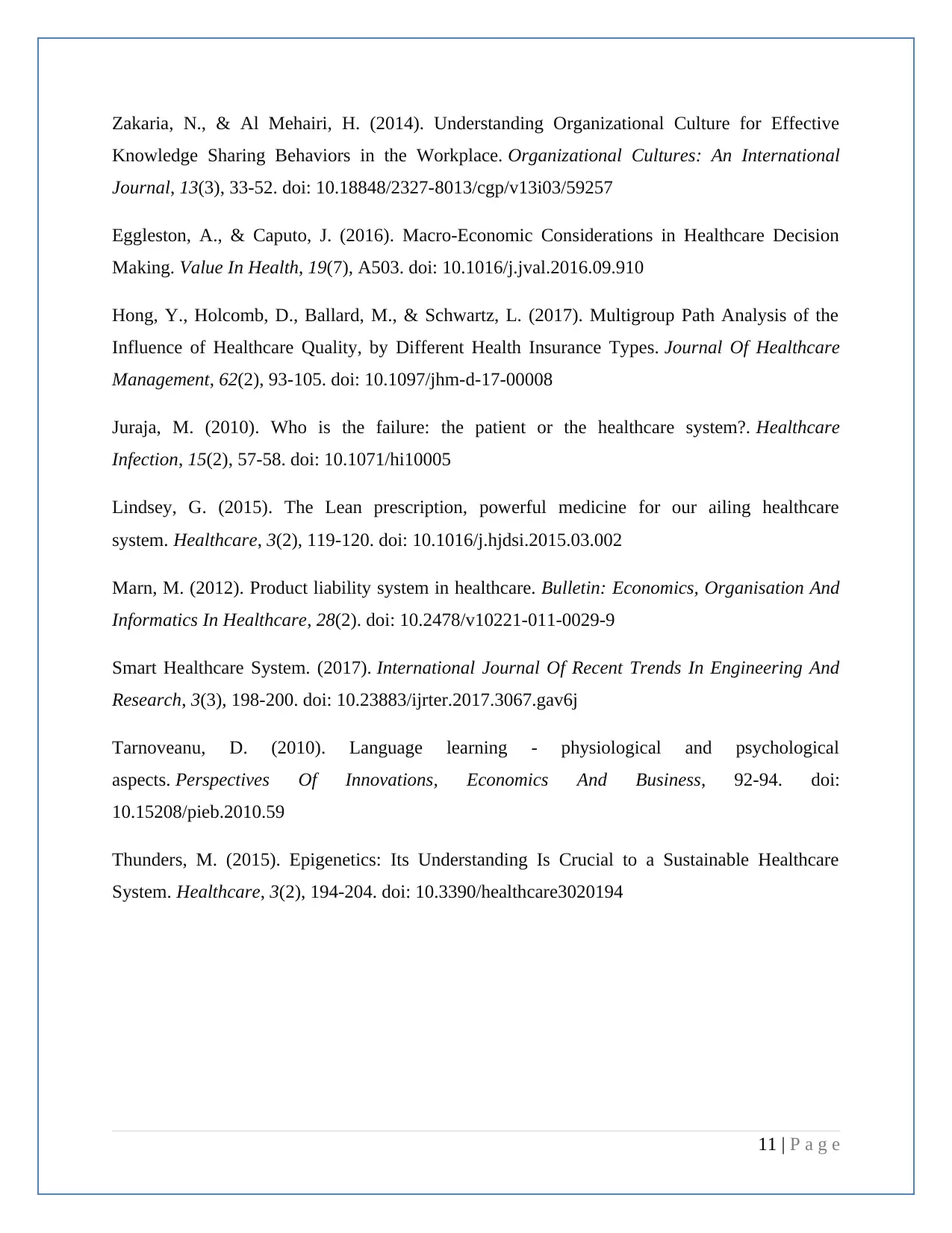
Zakaria, N., & Al Mehairi, H. (2014). Understanding Organizational Culture for Effective
Knowledge Sharing Behaviors in the Workplace. Organizational Cultures: An International
Journal, 13(3), 33-52. doi: 10.18848/2327-8013/cgp/v13i03/59257
Eggleston, A., & Caputo, J. (2016). Macro-Economic Considerations in Healthcare Decision
Making. Value In Health, 19(7), A503. doi: 10.1016/j.jval.2016.09.910
Hong, Y., Holcomb, D., Ballard, M., & Schwartz, L. (2017). Multigroup Path Analysis of the
Influence of Healthcare Quality, by Different Health Insurance Types. Journal Of Healthcare
Management, 62(2), 93-105. doi: 10.1097/jhm-d-17-00008
Juraja, M. (2010). Who is the failure: the patient or the healthcare system?. Healthcare
Infection, 15(2), 57-58. doi: 10.1071/hi10005
Lindsey, G. (2015). The Lean prescription, powerful medicine for our ailing healthcare
system. Healthcare, 3(2), 119-120. doi: 10.1016/j.hjdsi.2015.03.002
Marn, M. (2012). Product liability system in healthcare. Bulletin: Economics, Organisation And
Informatics In Healthcare, 28(2). doi: 10.2478/v10221-011-0029-9
Smart Healthcare System. (2017). International Journal Of Recent Trends In Engineering And
Research, 3(3), 198-200. doi: 10.23883/ijrter.2017.3067.gav6j
Tarnoveanu, D. (2010). Language learning - physiological and psychological
aspects. Perspectives Of Innovations, Economics And Business, 92-94. doi:
10.15208/pieb.2010.59
Thunders, M. (2015). Epigenetics: Its Understanding Is Crucial to a Sustainable Healthcare
System. Healthcare, 3(2), 194-204. doi: 10.3390/healthcare3020194
11 | P a g e
Knowledge Sharing Behaviors in the Workplace. Organizational Cultures: An International
Journal, 13(3), 33-52. doi: 10.18848/2327-8013/cgp/v13i03/59257
Eggleston, A., & Caputo, J. (2016). Macro-Economic Considerations in Healthcare Decision
Making. Value In Health, 19(7), A503. doi: 10.1016/j.jval.2016.09.910
Hong, Y., Holcomb, D., Ballard, M., & Schwartz, L. (2017). Multigroup Path Analysis of the
Influence of Healthcare Quality, by Different Health Insurance Types. Journal Of Healthcare
Management, 62(2), 93-105. doi: 10.1097/jhm-d-17-00008
Juraja, M. (2010). Who is the failure: the patient or the healthcare system?. Healthcare
Infection, 15(2), 57-58. doi: 10.1071/hi10005
Lindsey, G. (2015). The Lean prescription, powerful medicine for our ailing healthcare
system. Healthcare, 3(2), 119-120. doi: 10.1016/j.hjdsi.2015.03.002
Marn, M. (2012). Product liability system in healthcare. Bulletin: Economics, Organisation And
Informatics In Healthcare, 28(2). doi: 10.2478/v10221-011-0029-9
Smart Healthcare System. (2017). International Journal Of Recent Trends In Engineering And
Research, 3(3), 198-200. doi: 10.23883/ijrter.2017.3067.gav6j
Tarnoveanu, D. (2010). Language learning - physiological and psychological
aspects. Perspectives Of Innovations, Economics And Business, 92-94. doi:
10.15208/pieb.2010.59
Thunders, M. (2015). Epigenetics: Its Understanding Is Crucial to a Sustainable Healthcare
System. Healthcare, 3(2), 194-204. doi: 10.3390/healthcare3020194
11 | P a g e
⊘ This is a preview!⊘
Do you want full access?
Subscribe today to unlock all pages.

Trusted by 1+ million students worldwide
1 out of 12
Related Documents
Your All-in-One AI-Powered Toolkit for Academic Success.
+13062052269
info@desklib.com
Available 24*7 on WhatsApp / Email
![[object Object]](/_next/static/media/star-bottom.7253800d.svg)
Unlock your academic potential
Copyright © 2020–2025 A2Z Services. All Rights Reserved. Developed and managed by ZUCOL.





